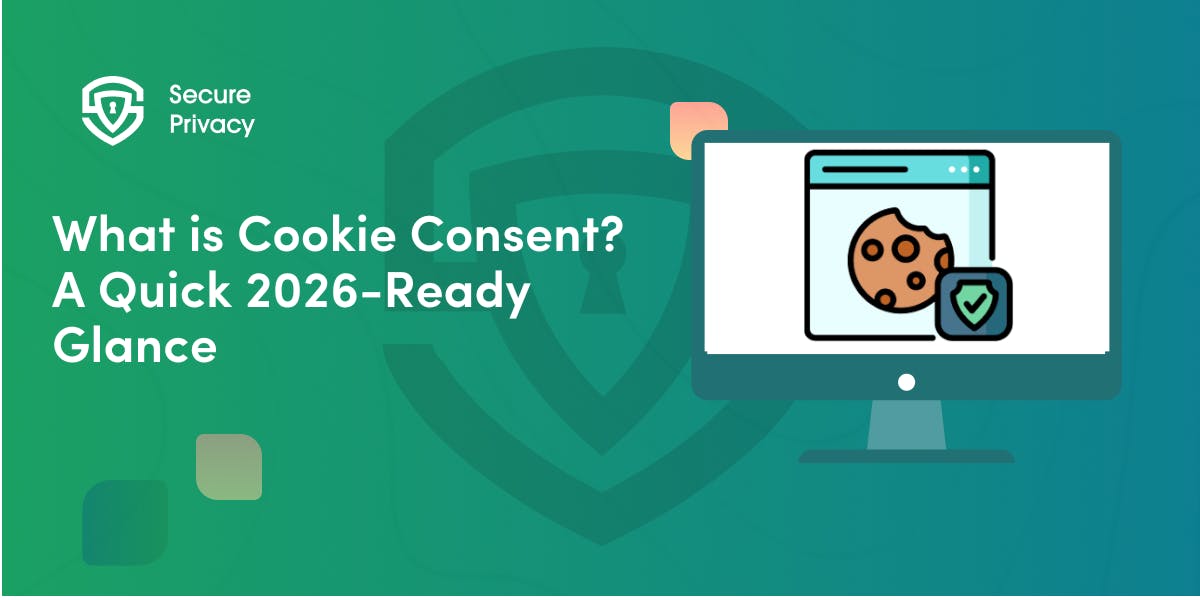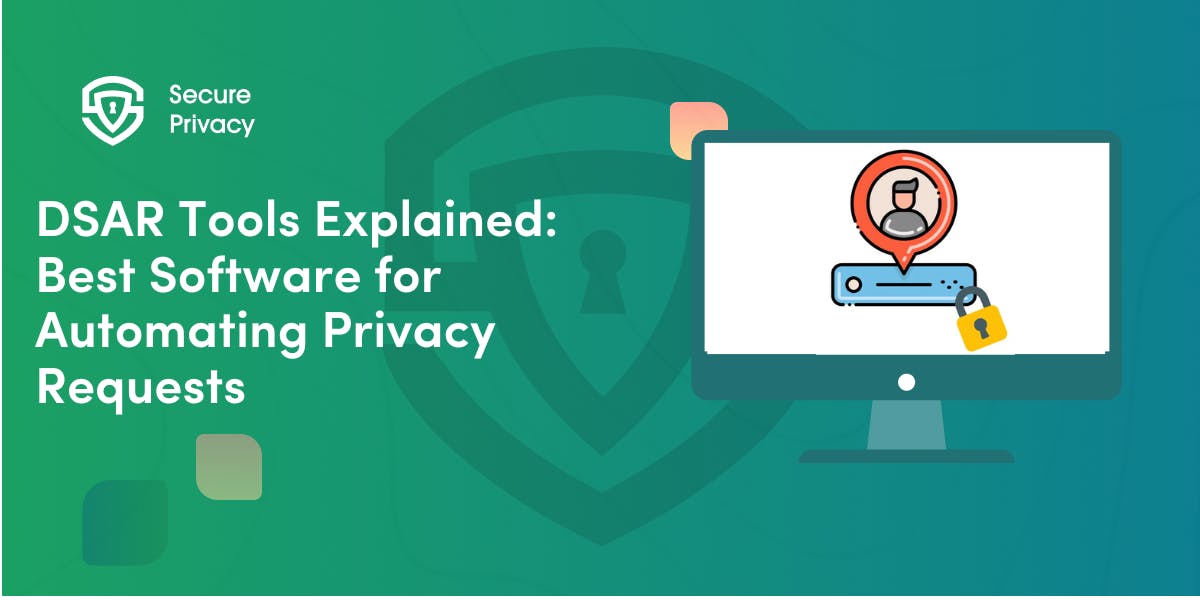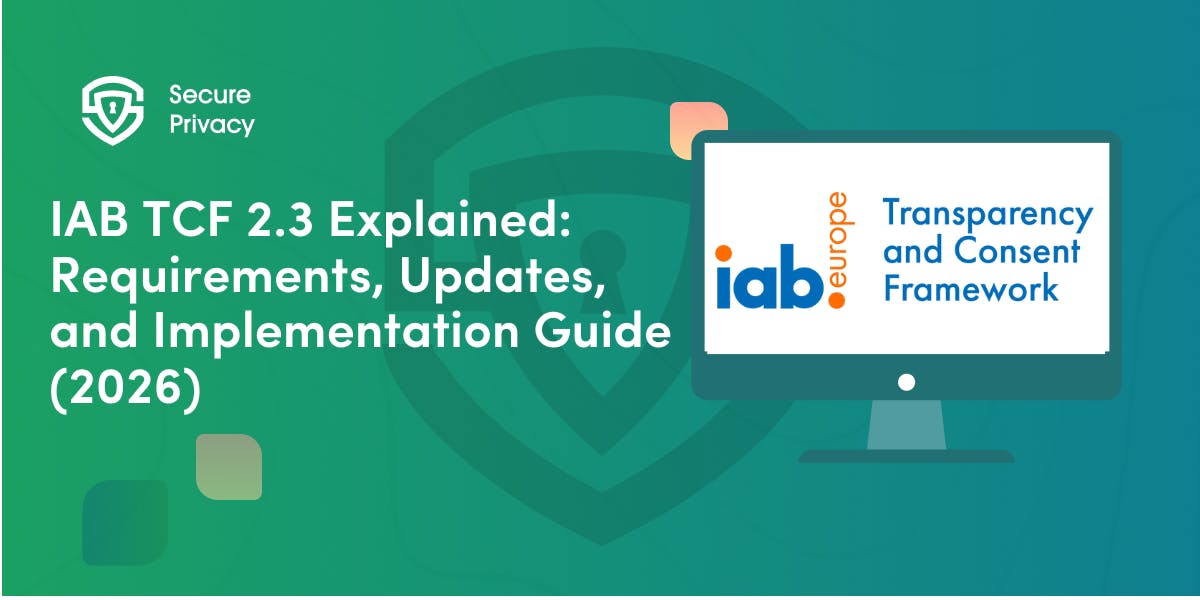Navigating IAB TCF 2.2: Essential Updates and How They Impact Your Privacy Practices
Stay ahead of evolving data privacy regulations with IAB TCF 2.2. Learn about the latest updates, compliance strategies, and how Secure Privacy’s Google-certified CMP simplifies your consent management.
As data protection regulations tighten globally, the latest update - IAB Transparency and Consent Framework (TCF) Version 2.2 - introduces several crucial changes aimed at enhancing transparency and consent management in line with the General Data Protection Regulation. This comprehensive guide will explore these updates, the framework's impact on compliance, and how publishers and vendors can effectively navigate these changes.
As TCF continues to evolve, understanding the progression from 2.2 to 2.3 helps publishers and vendors anticipate future requirements.
What is IAB TCF 2.2?
The IAB Transparency and Consent Framework (TCF) is a tool developed by the Interactive Advertising Bureau (IAB) to help organizations comply with the GDPR and ePrivacy Directive. TCF provides a standardized method for obtaining and managing user consent for data processing activities in digital advertising. The framework aims to enhance transparency and control for users while streamlining compliance for publishers and advertisers, particularly in version 2.2.
With the introduction of TCF 2.2, the framework has been updated to address evolving privacy challenges and provide more granular control over consent. This version builds on previous iterations, incorporating feedback from industry stakeholders to refine its guidelines and requirements.
What’s New in TCF 2.2?
TCF 2.2 introduces several significant updates and enhancements over its predecessor, TCF 2.1. One of the key changes is the introduction of new consent management requirements and transparency features. These updates include:
- Enhanced Consent Signals: TCF 2.2 provides more detailed consent signals, allowing for clearer communication of user preferences regarding data processing.
- Vendor Registration and Transparency: The new version requires vendors to register and provide detailed information about their data processing activities, improving transparency and accountability.
- Additional Consent Requirements: TCF 2.2 introduces additional consent requirements for specific data processing purposes, ensuring that users are fully informed and have control over their data.
These updates aim to address emerging privacy concerns and ensure that the framework remains effective in a rapidly evolving digital landscape, particularly regarding the total number of vendors involved.
How Does IAB TCF 2.2 Improve Transparency?
IAB TCF 2.2 brings some noticeable improvements when it comes to transparency. The whole point is to make sure users really know what’s happening with their data and can make informed choices. One big change is how the framework requires more detailed and clearer information about what data is being collected, why it’s being collected, and who’s using it. Instead of just vague descriptions, publishers now have to spell out exactly what’s going on, whether it’s for personalized ads, content recommendations, or analytics.
Another way TCF 2.2 boosts transparency is by giving users more control. The updated framework provides more granular options for users to pick and choose what they consent to, instead of just an all-or-nothing choice. Users can now decide what specific purposes they’re okay with, like agreeing to data collection for ads but opting out of data sharing with third parties.
Vendor transparency is also better. With TCF 2.2, there’s more visibility into which third-party companies are involved and what they’re doing with the data. Users can see a list of all the vendors and get a better understanding of how their data flows through the ad ecosystem.
Lastly, the language used in consent notices is more user-friendly now. The framework encourages simpler, more straightforward communication, making it easier for people to understand what they’re agreeing to. This isn’t just about compliance but also about building trust with users by being upfront and clear.
What Are the Key Features of IAB TCF 2.2?
IAB TCF 2.2 introduces several key features designed to improve the framework’s effectiveness:
- Granular Consent Management: Users can now provide or withdraw consent for specific purposes and vendors, enhancing their control over personal data usage.
- Enhanced Transparency: The framework requires more detailed disclosures about data processing activities, including the purposes and vendors involved.
- Integration with Consent Mode: TCF 2.2 supports integration with Google’s Consent Mode, allowing for better alignment with industry standards and practices.
- Updated Registration Fields: Publishers and vendors must now complete new registration fields, which include additional details about their data processing activities.
These features aim to address the evolving needs of both users and organizations, ensuring that consent management remains robust and compliant with the latest data protection regulations.
While TCF 2.2 brings significant improvements, the next iteration — TCF 2.3 — introduces even more comprehensive changes to further enhance publisher controls and transparency requirements.
How to Achieve Compliance with IAB TCF 2.2
Achieving compliance with IAB TCF 2.2 involves several key steps:
- Update Your Consent Management Platform (CMP): Ensure that your CMP is compatible with TCF 2.2 and supports the new features and requirements.
- Revise Consent Banners: Update your consent banners to reflect the new transparency and granularity requirements, providing users with clear information about their choices.
- Train Your Team: Educate your team about the changes in TCF 2.2 and how they impact your consent management practices.
- Monitor and Review: Regularly review your compliance status and make adjustments as needed to stay aligned with TCF 2.2 requirements.
To stay ahead of February 2026 enforcement, understand how v2.3 builds upon v2.2 requirements.
What Are the Challenges in Implementing TCF 2.2?
Implementing TCF 2.2 comes with its fair share of challenges for publishers, advertisers, and everyone in the digital ad ecosystem. One of the biggest issues is the complexity involved in managing consent choices across a growing number of vendors. The framework is more detailed than previous versions, meaning publishers have to be super precise about how they collect and manage user consent. This involves setting up more granular consent options, which can be tricky to do right without overwhelming users with too much information.
Another challenge is staying compliant while keeping a good user experience. TCF 2.2 pushes for clearer and more transparent consent notices, but making those pop-ups both informative and non-intrusive is tough. Publishers want to meet the requirements without annoying users, which is a delicate balance. If the consent process feels too complicated or disruptive, users might just bounce off the site altogether, leading to a case of lost engagement.
There’s also the challenge of vendor management. With TCF 2.2, publishers have to ensure that every third-party vendor they work with is also compliant and properly registered within the framework. Keeping track of all these relationships and making sure everything is up to date can be a logistical nightmare, especially for larger publishers with a long list of partners.
Tech integration is another hurdle. Implementing the framework often requires updates to existing consent management platforms (CMPs) or even switching to a new one that’s fully compatible with TCF 2.2. This can mean additional costs and development time, which not all businesses are ready to handle.
Lastly, there’s the issue of adapting to ongoing changes. Data privacy rules are always evolving, and TCF 2.2 is just one piece of the puzzle. Staying on top of all the regulatory updates and making sure your implementation is still compliant over time is an ongoing challenge.
How Does TCF 2.2 Affect Publishers?
IAB TCF 2.2 is a big deal for publishers because it changes how they handle user consent for data collection. Basically, it’s all about making sure users know what’s happening with their data and that they’re giving clear permission for it. Publishers now need to be much more detailed when explaining what data they’re collecting and why—like whether it’s for personalized ads, analytics, or content suggestions.
One of the key focuses is making everything more user-friendly. So, publishers need to improve how they ask for consent, making it simpler and easier to understand. This often means upgrading their consent management platforms (CMPs) to be more transparent and aligned with the new guidelines.
Another big shift is the added responsibility for publishers to keep tabs on the ad tech vendors they work with, including the total number of vendors they engage. Publishers have to make sure these vendors are TCF-compliant and that they’re handling user data properly. The framework gives publishers more control over who gets access to this data.
User rights are also emphasized more now. Things like letting users withdraw consent or access and delete their data need to be super easy to do. If publishers don’t get this right, they could face fines or lose access to certain ad services.
In short, TCF 2.2 pushes publishers to be clearer, more accountable, and better at handling user data, with the overall goal of making the digital advertising world more transparent and privacy-friendly.
What Role Do Consent Management Platforms (CMPs) Play in TCF 2.2?
Consent Management Platforms (CMPs) are at the heart of how TCF 2.2 works, making sure publishers and advertisers can handle user consent in a way that keeps them compliant with data privacy laws like the GDPR. Essentially, CMPs are the tools that pop up those consent banners you see on websites, explaining what data’s being collected and giving you the option to agree—or not. They store your preferences and make sure only the vendors you’ve approved can access your data.
A big part of what CMPs do is keep things transparent. They need to spell out clearly who’s collecting your data, what they’re using it for, and which third parties might get involved. This helps users feel more in control, letting them tweak settings and make informed consent choices about cookies so they can pick and choose what they’re okay with.
On the compliance side, CMPs are super important. They track and store all the consent data, which is crucial if a company needs to prove they’re following the rules. The pressure’s on them to be accurate, because if something goes wrong, it’s a big deal for everyone involved—publishers, advertisers, and the CMP itself.
Another key point is user experience. TCF 2.2 focuses a lot on making consent requests less annoying and more straightforward. CMPs have to get creative in how they present these options, finding ways to be clear without totally interrupting the user’s time on the site.
Lastly, CMPs are also responsible for handling things like requests to change consent or delete data. They provide the interface for users to easily manage their choices and rights, helping publishers and advertisers stay on the right side of the law.
So, CMPs are kind of the backbone of the whole TCF 2.2 setup, making sure everything runs smoothly between users, publishers, and the wider ad tech ecosystem.
How Do IAB TCF 2.2 Updates Compare with Previous Versions?
IAB TCF 2.2 makes several improvements over previous versions, focusing more on clarity and user control. One key difference is the push for clearer, more detailed explanations of how data is used. The updated framework requires more specific breakdowns of data purposes, letting users make more informed choices with more granular control over what they consent to.
Vendor management is also stricter now. Publishers must provide clearer information about third-party vendors and have more control over which ones can access user data, reducing unnecessary data sharing.
TCF 2.2 also emphasizes a better user experience. Compared to earlier versions, it encourages more streamlined and less intrusive consent banners, making it easier for users to understand and manage their preferences.
What Are the Benefits of Adopting TCF 2.2?
Adopting TCF 2.2 comes with some solid benefits, especially if you’re in the digital advertising space. First off, it helps you stay compliant with GDPR and other data privacy laws, which is huge. By following the framework established by IAB Europe, you’re showing regulators that you’re serious about protecting user data and respecting their consent choices. This reduces the risk of fines and legal issues, which can be costly and damaging to your reputation.
Another big plus is the improved user trust. TCF 2.2 is all about transparency and giving users more control, which can lead to better relationships with your audience. When people see that you’re clear about what you’re doing with their data and that you give them real choices, they’re more likely to feel comfortable and stay engaged with your site.
The framework also helps streamline vendor management. With TCF 2.2, you can be more selective about which third parties get access to user data, ensuring everyone you work with is playing by the same rules. This not only improves compliance but also reduces the risk of data misuse.
Lastly, adopting TCF 2.2 can lead to better ad performance. With clearer and more transparent consent processes, users are more likely to provide consent, which means you can still effectively target ads while staying compliant. It’s a win-win: you maintain revenue while respecting user privacy.
How to Integrate TCF 2.2 into Your Privacy Practices
To integrate TCF 2.2 into your privacy practices, start by using a CMP that supports it. This will help you collect and manage user consent more effectively. Next, update your privacy notices and consent banners to be clear and detailed about what data you’re collecting, why, and who it’s shared with.
Make sure your third-party vendors are compliant with TCF 2.2 and that you have proper agreements in place. Regularly review and test your consent processes to ensure they’re working well and adapting to any updates in data privacy laws.
Easy IAB TCF v2.2 Compliance with Secure Privacy
Secure Privacy, a Google-certified CMP, is designed to make TCF v2.2 compliance straightforward and efficient. With Secure Privacy, you can easily manage user consent, ensuring you meet all regulatory requirements while maintaining transparency. The platform also helps you stay on top of vendor compliance, so you don’t have to worry about third parties mishandling data.
Don’t let complex privacy regulations slow you down. Secure Privacy’s advanced tools and user-friendly interface take the hassle out of consent management, making it easier to keep your practices up-to-date and compliant. Schedule a demo with Secure Privacy today and streamline your privacy management—because staying compliant should be simple and stress-free.
Get Started For Free with the
#1 Cookie Consent Platform.
No credit card required

What is Cookie Consent? A Quick 2026-Ready Glance
Your website loads. Cookies track users. But without proper cookie consent, you're violating GDPR — risking fines up to €20 million or 4% of global revenue. Cookie consent is the legally required mechanism by which websites obtain explicit user approval before deploying non-essential tracking technologies. This requirement stems from GDPR Article 4(11) and the ePrivacy Directive, mandating that consent must be freely given, specific, informed, and unambiguous.
- Legal & News

DSAR Tools Explained: Best Software for Automating Privacy Requests
You're drowning in data subject access requests. Manual searches through dozens of systems miss regulatory deadlines and expose organizations to fines starting at $2,500 per violation. The solution? DSAR tools — purpose-built software that automates the entire process of responding to data subject access requests, from intake to delivery.
- Legal & News

IAB TCF 2.3 Explained: Requirements, Updates, and Implementation Guide (2026)
Your ad revenue dropped 40% overnight. Google stopped bidding on your inventory. Your DSP partners flagged your traffic as non-compliant. The culprit? An outdated TCF 2.2 consent string after the February 2026 enforcement deadline.
- Legal & News
- Cookie Consent

